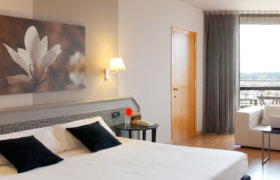This website uses cookies so that we can provide you with the best user experience possible. Cookie information is stored in your browser and performs functions such as recognising you when you return to our website and helping our team to understand which sections of the website you find most interesting and useful.
Route through the Modernista and Noucentista Granollers
Granollers is a city with elegant buildings from the Modernista era
This route goes through the centre of the city and visits some of the most representative buildings from this era.
Since the mid-19th century, with the new main road from Barcelona to Ribes and the arrival of the railway, Granollers started to grow considerably, in economic but especially in industrial terms.
This led to the construction of a large number of public buildings (town hall, schools and health centres), factories, homes for workers and town palaces for the wealthy, all in the Modernista and Noucentista style.
These buildings were designed by renowned architects such as F. Mariné, J. Martorell, S. Cordomí, A. Ruiz, but the prime example of Modernisme in the county was M. J. Raspall.
This Modernista route through Granollers, lasting approximately one hour, provides a return to the industrial past of great homes and façades with a unique charm.
Hospital Asil de Granollers (1923)
The Hospital Asil de Granollers, promoted by Francesc Ribas i Serra, is a Modernista building built as a complex made up of three pavilions. It is particularly interesting for the use of bare brickwork on its façades. It’s an austere but interesting building, decorated with a simple ceramic impost that unifies the three pavilions.
Granollers Town Hall (1904)
Granollers Town Hall is the work of the municipal architect Simón Cordomí Carrera, replacing the old building of the Casa de la Vila which was in a bad state of repair. The work carried out by the sculptor Josep Maria Barnadas was decisive in the clearly medieval character adopted by the building.
Sala Francesc Tarafa (14th century)
Formerly the city hospital, documented since 1328. This was remodelled in 1926 by the architect M. J. Raspall, a leading figure in the county for the Modernisme movement, who converted the hospital into a library. Two Gothic windows from an old house were placed on the façade and the interior was decorated in the Modernista style.
Casa Clapés Façade (1904)
Casa Clapés is an example of typically Modernista decoration. It’s an old house of medieval origin remodelled by M. J. Raspall, whose signature can be seen on the façade.
Casa Bossy Façade (1924)
Designed in 1924 by the architect M. J. Raspall, this is a very austere work in comparison with his Modernista designs. The building has a ground and first floor and a notable tower-viewpoint, from where you can see the neighbouring Plaça de la Porxada.
Casa Torrabadella. Can Ramoneda Façade (1902)
Casa Torrabadella. Can Ramoneda was designed by the municipal architect Francesc Mariné and is an eclectic building with Renaissance and historicist features.
The gazebo has impressive Modernista sgraffito, leaded stained glass and fish scale tiles.
Can Puntas Façade (1912)
An old house of medieval origin built outside the city walls and remodelled by the Modernista architect M. J. Raspall. Its sgraffito and leaded stained glass with floral motifs are particularly interesting. Its façade is more austerely decorated than most of the works by M. J. Raspall.
Casa Blanxart Façade (1904)
Miquel Blanxart i Estapé, heir to one of the richest families in the county, was an important producer of the spirit known as “aiguardent” and also mayor of the city. The most interesting feature of this building is the interaction of the sculptural and architectural elements on the ground floor, designed by Josep Maria Barnadas, as well as the large balcony and sgraffito decoration on the upper part.
The sculpture of a nymph touching some grapes refers to the fact that it had previously been the old Faust anise factory. Both the female figure and the sgraffito reliefs on the floors make this house one of the most singular in the Modernisme style, not only in the Vallès county but in the whole of Catalonia, without forgetting the work on the wrought iron railings.
Casa Joan Sanpera Façade (1912)
Joan Sanpera, born in 1840 in Granollers, made his fortune by importing products from the Americas. When he was old, he returned to his local district (El Lledoner) to build a summer home in 1912. This is one of the city’s grandest mansions.




